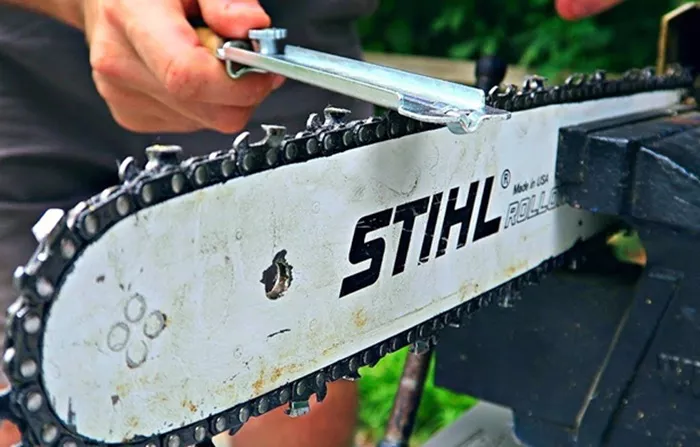Keeping your chainsaw blade sharp is crucial for efficient cutting and prolonging the life of your tool. A sharp blade not only makes cutting easier but also ensures safety and precision. With various chainsaw blade sharpeners available, selecting the right one can be overwhelming. This ultimate guide will help you understand the different types of sharpeners, their pros and cons, and provide tips for choosing the best tool to maintain your chainsaw’s edge.
Product Overview
Chainsaw blade sharpeners come in three main types:
Manual Sharpeners: These include files and sharpening kits. They are cost-effective and portable but require some skill and effort to use.
Electric Sharpeners: These tools use an electric motor to grind the blade. They are efficient and easy to use but can be more expensive and require a power source.
Mounted Sharpeners: Often designed for use in a workshop, these sharpeners are mounted on a stand or bench and offer precise sharpening but can be bulky and less portable.
Advantages and Disadvantages of Chainsaw Blade Sharpeners
1. Manual Sharpeners
Types: Files, hand-held sharpeners, and sharpening kits.
Price Range: $15 – $50
Advantages
Cost-Effective: Generally cheaper than electric or mounted sharpeners.
Portability: Easy to carry and use in various locations.
Simplicity: No need for power or complex setups.
Disadvantages
Effort Required: Requires manual effort and skill to achieve a sharp edge.
Time-Consuming: Sharpening can take longer compared to electric models.
Inconsistent Results: May not provide as uniform an edge as electric sharpeners.
2. Electric Sharpeners
Types: Bench-mounted electric sharpeners and rotary tools.
Price Range: $60 – $200
Advantages
Efficiency: Sharpen blades quickly and with less effort.
Ease of Use: Often come with guides and instructions for consistent sharpening.
Precision: Provides a more uniform edge compared to manual sharpeners.
Disadvantages
Higher Cost: More expensive than manual sharpeners.
Power Dependency: Requires an electrical outlet or battery power.
Bulkiness: Can be heavy and less portable.
3. Mounted Sharpeners
Types: Bench-mounted sharpeners with adjustable guides.
Price Range: $100 – $300
Advantages
Precision: Offers precise and consistent sharpening with adjustable settings.
Durability: Built to last and handle frequent use in a workshop setting.
Efficiency: Provides quick sharpening with minimal effort.
Disadvantages
Size: Larger and less portable, suitable for stationary use.
Higher Cost: Generally more expensive than manual or basic electric models.
Setup Required: Needs to be mounted or set up in a fixed location.
See also: Top 5 Chainsaw Sharpeners Reviewed And Rated
Comparison with Competitors of Chainsaw Blade Sharpeners
When comparing chainsaw blade sharpeners, consider these factors:
Performance: Electric and mounted sharpeners usually offer faster and more consistent results than manual sharpeners. They are ideal for frequent use and larger projects.
Portability: Manual sharpeners excel in portability and are useful for on-the-go sharpening. They are ideal for occasional use or for those who need a sharpener in different locations.
Cost: Manual sharpeners are the most affordable option, while electric and mounted sharpeners come at higher prices but offer greater efficiency and precision.
Ease of Use: Electric sharpeners are generally easier to use, with less physical effort required. Manual sharpeners require more skill and effort to achieve a sharp edge.
Specific Prices
Manual Sharpeners: Typically priced between $15 and $50, these are an affordable choice for occasional use and beginners.
Electric Sharpeners: Range from $60 to $200, offering efficiency and ease of use for regular maintenance.
Mounted Sharpeners: Cost between $100 and $300, providing precision and durability for frequent use in a workshop setting.
Purchase Recommendations
For Occasional Use: A manual sharpener is a cost-effective and portable option. It is ideal for users who only need to sharpen their chainsaw blade infrequently and prefer a simple, low-cost solution.
For Frequent Use: An electric sharpener is recommended for those who need quick and easy sharpening. It is suitable for users who maintain their chainsaw regularly and value efficiency and consistency.
For Workshop Settings: A mounted sharpener is best for users who have a dedicated workspace and need precise and consistent sharpening. It’s ideal for professionals or avid users who sharpen multiple blades frequently.
See also: Evaluating Chainsaw Sharpeners: Which Model Offers The Best Performance?
FAQs
1. How often should I sharpen my chainsaw blade?
It depends on usage, but generally, you should sharpen your chainsaw blade every few hours of cutting time. If you notice decreased performance or difficulty cutting, it’s time for a sharpening.
2. Can I use a chainsaw blade sharpener on different types of blades?
Most sharpeners are designed to work with standard chainsaw blades. However, check the sharpener’s specifications to ensure it is compatible with the type of blade you are using.
3. How do I know if my chainsaw blade is properly sharpened?
A properly sharpened blade will cut smoothly and easily through wood. If the blade struggles or leaves rough cuts, it may need more sharpening or alignment.
4. Are there any safety tips for using a chainsaw blade sharpener?
Always follow the manufacturer’s instructions for safe use. Wear safety glasses and gloves, and ensure the sharpener is securely positioned before starting. For electric and mounted models, keep hands away from moving parts.
Conclusion
Choosing the right chainsaw blade sharpener depends on your specific needs and preferences. Manual sharpeners are affordable and portable, making them a good choice for occasional use. Electric sharpeners offer convenience and efficiency, ideal for frequent use. Mounted sharpeners provide precision and durability for professional settings. By considering your usage frequency, budget, and desired features, you can find the best sharpener to keep your chainsaw blade in top condition and ensure optimal performance.
Related Topics:
-
Comparing Mini Portable AC Prices: Which Models Offer The Best Value?
-
Dewalt 20V Vacuum: A Detailed Look At Its Design And Functionality
-
Is The Stihl Mini Chainsaw Worth The Investment? A Detailed Review
-
Electric Garage Heaters Compared: Which Model Provides The Best Heating For Your Needs?

